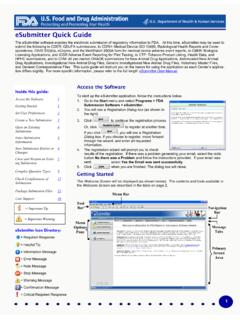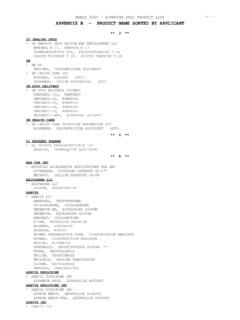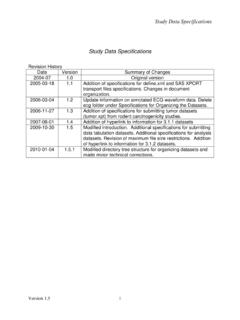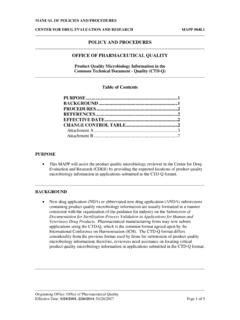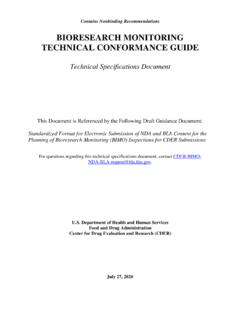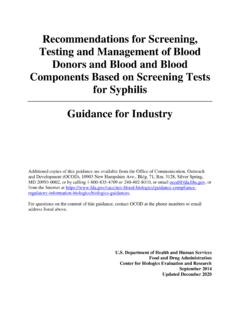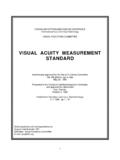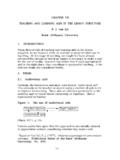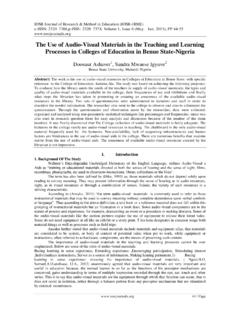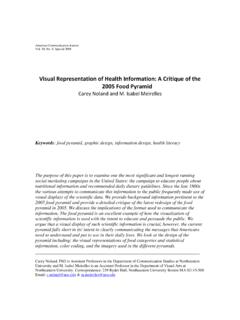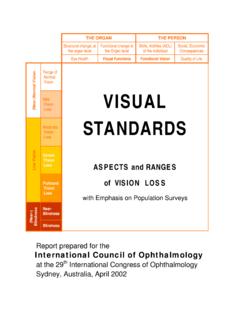Transcription of Hearing Aids: The Basic Information You Need to Know
1 Hearing aids : The Basic Information You Need to KnowFDA basics WEBINARMay 23, 2012 Presented by Shu Chen Peng, CCC AScientific Reviewer in AudiologyCenter for Devices and Radiological Health2 Outline Hearing loss basics about Hearing aids What are Hearing aids and who are they for? How does a Hearing aid work? Styles and common features Getting the most out of your Hearing aids Hearing aid fitting & care Hearing aid benefits & limitations Learning to listen with Hearing aids Hearing aids vs. Personal Sound Amplifying Products Questions & Answers 3 Facts about Hearing Loss Individuals with Hearing loss may be limited in daily oral communication.
2 Some facts about Hearing loss & Hearing aids (NIDCD/NIH) 36 million (or 17%) adult population in the US report some degree of Hearing loss. Less than 20% of those with Hearing loss who might benefit from treatment actually seek help. Most Hearing aid users had lived with Hearing loss for 10+ years, and waited until it progressed to moderate to severe levels before seeking professional help for Hearing aid of Hearing Loss Conductive: Middle ear pathology Sensorineural: Damage at the inner ear (cochlea) Mixed: Both cochlear damage & outer/middle ear pathology5 Degrees of Hearing Loss 0 20 dB HL: Within normal limits (WNL) 20 40 dB HL: Mild 40 70 dB HL: Moderate 70 90 dB HL: Severe > 90 dB HL: ProfoundmildsevereprofoundmoderateWNL6 Who are Hearing aids for?
3 Sound amplifying medical devices to aid individuals with Hearing loss. Hearing aids may be useful for: Hearing loss that may or may not be medically treatable. Any type of Hearing loss, as long as the individual needs compensation for the reduction in Hearing . Selection of Hearing aids should be based on the type and severity of Hearing loss, listening needs , and aids : Basic Components & How They Work Electronic components: Microphone Amplifier circuitry Miniature loudspeaker/receiver Battery How does a Hearing aid work? Aid Styles Behind the ear (BTE) aids : A plastic case containing most parts.
4 Resting behind the ear connected to an earmold Easy to be cleaned and handled, relatively sturdy "Mini" BTE (or "on the ear") aids : A very thin tube connects the aid to the ear canal May have an open fit ear tip or a regular earmold With open fit Reduced occlusion ("plugged up ) sensations, increased comfort, relatively less visible(NIDCD/NIH)(Siemens Hearing Instruments)9 Hearing Aid Styles In the ear (ITE) aids : All parts contained in a shell, which fills in the ear canal Relatively easier to handle than smaller aids such as ITC & CIC In the canal (ITC) aids & completely in the canal (CIC) aids : All parts contained in tiny cases, which fits partly or completely in the ear canal Smallest in size, which makes it difficult to handle and adjust for some usersITEITCCIC(Siemens Hearing Instruments)10 Hearing Aid Technology: Analog vs.
5 Digital Analog Converting physical sound waves into electrical waves Making the continuous sound waves larger Digital Converting sound waves to their binary format where the sound is represented by a series of 1 s and 0 s Allowing manipulating sounds in relatively flexible ways to achieve more programming options. 11 Common Hearing Aid Features Directional microphones Sound from a specific direction amplified to a greater level May help listeners to understand speech in noisy environments Feedback suppression Squeals suppressed when the Hearing aid gets too close to the phone or has a loose fitting earmold T coil (Telephone switch) Sound picked up from the telephone when switching to the "T coil" setting Help to reduce the chance of Hearing aid "whistling" Also works well in environments ( , theaters, auditoriums, etc.)
6 Where there is induction loop or FM installation12 Hearing Aid Fitting Get a medical check up from a licensed physician to rule out any medical reasons for Hearing loss. In some cases, Hearing loss is medically or surgically treatable. Certain medical conditions may underlie the person s Hearing loss. Seek Hearing aid fitting from a licensed Hearing healthcare professional. Audiological exam, including Hearing evaluation Provide proper gain and setting: Too much amplification may cause discomfort & additional Hearing loss. 13 Hearing Aid Fitting (cont d)Questions to consider: What styles and features would fit my daily needs ?
7 Cost: What is the total cost of the Hearing aids ? Do the benefits of newer technologies outweigh the higher costs? Trial/adjustment period: Is there a trial or adjustment period for me to try out the Hearing aids ? What fees are nonrefundable if I decide to return the Hearing aids ? Care & Warranty: How should I care for my Hearing aids ? What is covered during the period of warranty? How long is the warranty? Can it be extended? 14 Hearing Aid Care & Maintenance Keep Hearing aids away from any moisture and heat, which may cause damage to the internal electronics. Clean Hearing aids as instructed.
8 Power consumption & battery safety: Turn off Hearing aids when not in use. Keep batteries and Hearing aids away from children and pets. Visit the Hearing healthcare professional on a regular basis to have Hearing aids Aid Benefits & LimitationsBenefits Ability to hear sounds that could not be heard previously, and help oral communication Ability to hear speech over the telephone Limitations Do not restore normal Hearing All sounds, including background noise and undesired sounds, are made louder. Sounds, including own voice, might seem too loud at first. May need to be replaced every several years16 Learning to Listen with Hearing aids Understand your Hearing loss & set realistic expectations Allow yourself time to adjust and request fine tuning Involve your family members to understand Hearing loss and Hearing aids Learn about communication strategies, including dealing with background noise & utilizing visual cues Join support groups Learn about Assistive Listening Devices (ALDs)17 Hearing aids vs.
9 Personal Sound Amplification Products (PSAPs) Hearing aids Any wearable sound amplifying medical device Aiding persons with, or compensating for impaired hearingPSAPs NOT medical devices; wearable electronic consumer products Amplifying environmental sound for non Hearing impaired consumers for use in a variety of listening situations Not intended or labeled to compensate for Hearing lossQuestions?For more Information about Hearing aids , please refer to the FDA website on Hearing aids at.
